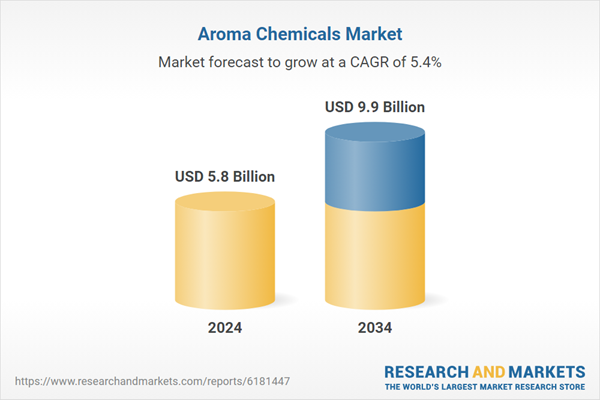Aroma chemicals are a core ingredient in flavor and fragrance formulations, widely used in personal care, household items, food, and beverages. Their role in shaping scent and taste experiences strongly influences consumer preferences and purchasing behavior. Market growth is being fueled by shifting lifestyle patterns, increased disposable incomes, and rising consumer demand for sensory-driven products. The growing preference for personalized and premium items across beauty, grooming, and edible goods is accelerating the demand for sophisticated aroma compounds, pushing manufacturers to develop more complex scent profiles using both synthetic and natural ingredients. As consumer expectations evolve toward cleaner, high-performance, and sustainable products, innovation within aroma chemistry is becoming increasingly essential to stay competitive and relevant in global markets.
In 2024, the benzenoids segment generated USD 2.2 billion. Their versatility in scent compositions, ranging from floral to spicy notes, makes them integral to food, beverage, and personal care products. Advances in synthesis methods and the ability to produce high-purity benzenoids at scale enhance their appeal, especially among brands aiming for cost efficiency without sacrificing quality. Regulatory compliance is also a key benefit, as these compounds are manufactured under strict quality standards, making them reliable for broad applications.
The synthetic aroma chemicals segment accounted for a 55.4% share in 2024, driven by affordability, reliable quality, and scalable production. These lab-made compounds offer fragrance manufacturers precise control over scent characteristics and are ideal for high-volume industries such as cosmetics, household care, and packaged food. They are also preferred due to lower production costs, faster lead times, and broader availability compared to natural sources.
North America Aroma Chemicals Market held a CAGR of 5.3% in 2024, backed by a developed food processing ecosystem and rising demand for packaged consumables. Aroma chemicals in the region are widely used to enhance flavor, texture, and shelf life in processed meat, seafood, dairy, and bakery products. Phosphate-based compounds are extensively utilized in various food applications to meet regulatory food safety standards while improving overall product performance. This strong demand across multiple verticals, paired with high consumer awareness, ensures steady regional growth.
Key players in the Global Aroma Chemicals Market include PFW Aroma Chemicals (Kelkar Group), MANE, Symrise AG, Takasago International Corporation, International Flavors & Fragrances Inc., Givaudan, S H Kelkar and Company, Robertet, BASF SE, LANXESS, Hindustan Mint and Agro, and Kao Corporation. To strengthen their position, key players are focusing on expanding their global supply chains, upgrading manufacturing technologies, and increasing investments in R&D. Many companies are developing customized aroma solutions tailored to regional preferences and regulatory requirements. Strategic mergers, partnerships, and acquisitions are helping players scale operations and diversify their product portfolios.
Comprehensive Market Analysis and Forecast
- Industry trends, key growth drivers, challenges, future opportunities, and regulatory landscape
- Competitive landscape with Porter’s Five Forces and PESTEL analysis
- Market size, segmentation, and regional forecasts
- In-depth company profiles, business strategies, financial insights, and SWOT analysis
This product will be delivered within 2-4 business days.
Table of Contents
Companies Mentioned
The companies profiled in this Aroma Chemicals market report include:- BASF SE
- Givaudan
- Hindustan Mint and Agro
- International Flavors & Fragrances Inc.
- Kao Corporation
- LANXESS
- MANE
- PFW Aroma Chemicals (Kelkar Group)
- Robertet
- S H Kelkar and Company
- Symrise AG
- Takasago International Corporation
Table Information
| Report Attribute | Details |
|---|---|
| No. of Pages | 210 |
| Published | October 2025 |
| Forecast Period | 2024 - 2034 |
| Estimated Market Value ( USD | $ 5.8 Billion |
| Forecasted Market Value ( USD | $ 9.9 Billion |
| Compound Annual Growth Rate | 5.4% |
| Regions Covered | Global |
| No. of Companies Mentioned | 13 |









